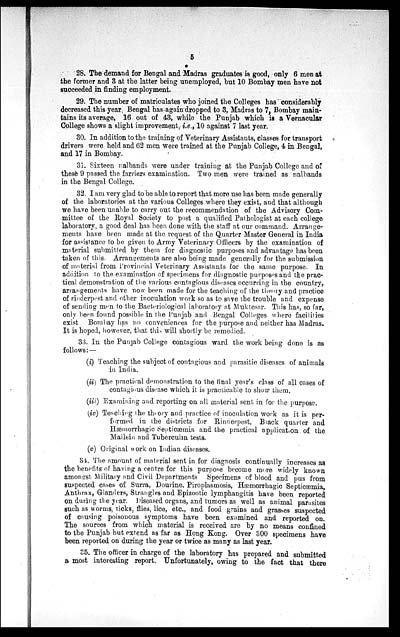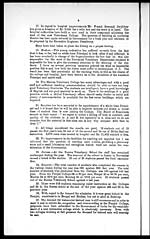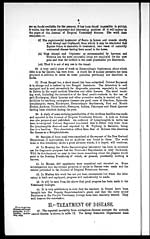Medicine - Veterinary > Civil Veterinary Departments > Annual administration report of the Civil Veterinary Department of India > 1908-1909 > Part A - Provincial administration
(12) Page 5
Download files
Individual page:
Thumbnail gallery: Grid view | List view

5
28. The demand for Bengal and Madras graduates is good, only 6 men at
the former and 3 at the latter being unemployed, but 10 Bombay men have not
succeeded in finding employment.
29. The number of matriculates who joined the Colleges has considerably
decreased this year, Bengal has again dropped to 3, Madras to 7, Bombay main-
tains its average, 16 out of 43, while the Punjab which is a Vernacular
College shows a slight improvement, i.e., 10 against 7 last year.
30. In addition to the training of Veterinary Assistants, classes for transport
drivers were held and 62 men were trained at the Punjab College, 4 in Bengal,
and 17 in Bombay.
31. Sixteen nalbands were under training at the Punjab College and of
these 9 passed the farriers examination. Two men were trained as nalbands
in the Bengal College.
32. I am very glad to be able to report that more use has been made generally
of the laboratories at the various Colleges where they exist, and that although
we have been unable to carry out the recommendation of the Advisory Com-
mittee of the Royal Society to post a qualified Pathologist at each college
laboratory, a good deal has been done with the staff at our command. Arrange-
ments have been made at the request of the Quarter Master General in India
for assistance to be given to Army Veterinary Officers by the examination of
material submitted by them for diagnostic purposes and advantage has been
taken of this. Arrangements are also being made generally for the submission
of material from Provincial Veterinary Assistants for the same purpose. In
addition to the examination of specimens for diagnostic purposes and the prac-
tical demonstration of the various contagious diseases occurring in the country,
arrangements have now been made for the teaching of the theory and practice
of rinderpest and other inoculation work so as to save the trouble and expense
of sending men to the Bacteriological laboratory at Muktesar. This has, so far,
only been found possible in the Punjab and Bengal Colleges where facilities
exist Bombay has no conveniences for the purpose and neither has Madras.
It is hoped, however, that this will shortly be remedied.
33. In the Punjab College contagious ward the work being done is as
follows:—
(i) Teaching the subject of contagious and parasitic diseases of animals
in India.
(ii) The practical demonstration to the final year's class of all cases of
contagious disease which it is practicable to show them.
(iii) Examining and reporting on all material sent in for the purpose.
(iv) Teaching the theory and practice of inoculation work as it is per-
formed in the districts for Rinderpest, Black quarter and
Hæmorrhagic Septicæmia and the practical application of the
Mallein and Tuberculin tests.
(v) Original work on Indian diseases.
34. The amount of material sent in for diagnosis continually increases as
the benefits of having a centre for this purpose become more widely known
amongst Military and Civil Departments Specimens of blood and pus from
suspected cases of Surra, Dourine, Piroplasmosis, Hæmorrhagic Septicæmia,
Anthrax, Glanders, Strangles and Epizootic lymphangitis have been reported
on during the year. Diseased organs, and tumors as well as animal parasites
such as worms, ticks, flies, lice, etc., and food grains and grasses suspected
of causing poisonous symptoms have been examined and reported on.
The sources from which material is received are by no means confined
to the Punjab but extend as far as Hong Kong. Over 300 specimens have
been reported on during the year or twice as many as last year.
35. The officer in charge of the laboratory has prepared and submitted
a most interesting report. Unfortunately, owing to the fact that there
Set display mode to: Large image | Zoom image | Transcription
Images and transcriptions on this page, including medium image downloads, may be used under the Creative Commons Attribution 4.0 International Licence unless otherwise stated. ![]()
| Permanent URL | https://digital.nls.uk/75509846 |
|---|




